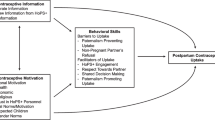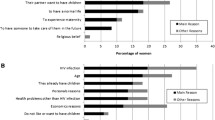Abstract
The HIV epidemic in sub-Saharan Africa disproportionately affects women of reproductive age. The increasing provision of Highly Active Anti-Retroviral Therapy (HAART) with improved prognosis and maternal-fetal outcomes calls for an understanding of fertility planning for HIV-positive women. We describe the effect of HIV and HAART on pregnancy desires and contraceptive use among HIV-positive women in Soweto, South Africa. Focus group discussions and in-depth interviews were conducted with 42 HIV-positive women of reproductive age. Analysis was performed using ATLAS-ti (ATLAS-ti Center, Berlin). Emergent themes were impact of HIV diagnosis on pregnancy intentions; factors affecting contraceptive uptake including real and normative side effects, body image, and perceived vaginal wetness; and the mitigating influence of partnership on both pregnancy intentions and contraceptive use. Routine counseling about pregnancy desires and contraception should be offered to HIV-positive women.
Similar content being viewed by others
References
Bambra, C. S. (1999). Current status of reproductive behaviour in Africa. Human Reproduction Update, 5(1), 1–20. doi:10.1093/humupd/5.1.1.
Beksinska, M. E., Rees, H. V., Kleinschmidt, I., & McIntyre, J. (1999). The practice and prevalence of dry sex among men and women in South Africa: A risk factor for sexually transmitted infections? Sexually Transmitted Infections, 75(3), 178–180. doi:10.1136/sti.75.3.178.
Bernard, H. R. (2001). Unstructured and semi-structured intervewing. In H. R. Bernard (Ed.), Research methods in anthropology: Qualitative and quantitative approaches (3rd ed., pp. 208–236). Walnut Creek, CA: AltaMira Press.
Chen, J. L., Philips, K. A., Kanouse, D. E., Collins, R. L., & Miu, A. (2001). Fertility desires and intentions of HIV-positive men and women. Family Planning Perspectives, 33(4), 144–152.
Chirgwin, K. D., Feldman, J., Muneyyirci-Delale, O., Landesman, S., & Minkoff, H. (1996). Menstrual function in human immunodeficiency virus-infected women without acquired immunodeficiency syndromes. Journal of Acquired Immune Deficiency Syndromes and Human Retrovirology, 12(5), 489–494.
Dyer, S., Mokoena, N., Maritz, J., & van der Spuy, Z. (2008). Motives for parenthood among couples attending a level 3 infertility clinic in the public health sector in South Africa. Human Reproduction (Oxford, England), 23(2), 352–357. doi:10.1093/humrep/dem279.
Ellerbrock, T. V., Wright, T. C., Bush, T. J., Dole, P., Brudney, K., & Chiasson, M. A. (1996). Characteristics of menstruation in women infected with human immunodeficiency virus. Obstetrics and Gynecology, 87(6), 1030–1034. doi:10.1016/0029-7844(96)00047-6.
Garcia, P. M., Kalish, L. A., Pitt, J., Minkoff, H., Quinn, T. C., Burchett, S. K., et al. (1999). Maternal level of plasma HIV-1 RNA and the risk of perinatal transmission. The New England Journal of Medicine, 341(6), 394–402. doi:10.1056/NEJM199908053410602.
Glaser, B. (1992). Basics of grounded theory analysis. Mill Valley, CA: Sociology Press.
Harries, J., Cooper, D., Myer, L., Bracken, H., Zweigenthal, V., & Orner, P. (2007). Policy maker and health care provider perspectives on reproductive decision-making amongst HIV-infected individuals in South Africa. Biomed Central Public Health, 7, 282.
Health Systems Trust. (2008). Health Statistics. Retrieved June 5, 2008, from http://www.hst.org.za/healthstats/index.php?indtype_id=003006002.
Hoffman, I. F., Martinson, F. E., Powers, K. A., Chilongozi, D. A., Msiska, E. D., Kachipapa, E. I., et al. (2008). The year-long effect of HIV-positive test results on pregnancy intentions, contraceptive use, and pregnancy incidence among Malawian women. Journal of Acquired Immune Deficiency Syndromes, 47(4), 477–483.
Homsy, J., Bunnell, R., Moore, D., King, R., Malamba, S., Nakityo, R., Glidden, D., Tappero, J., & Mermin, J. (2009). Reproductive intentions and outcomes among women on antiretroviral therapy in rural Uganda: A prospective cohort study. PLoS ONE, 4(1), e4149. doi:10.1371/journal.pone.0004149 http://www.plosone.org/article/info:doi/10.1371/journal.pone.0004149.
Kaida, A., Andia, I., Maier, M., Strathdee, S. A., Bangsberg, D. R., Spiegel, J., et al. (2006). The potential impact of antiretroviral therapy on fertility in sub-Saharan Africa. Current HIV/AIDS Reports, 3(4), 187–194. doi:10.1007/s11904-006-0015-0.
Kaida, A., Gray, G., Bastos, F. I., Andia, I., Maier, M., McIntyre, J., et al. (2008). The relationship between HAART use and sexual activity among HIV-positive women of reproductive age in Brazil, South Africa and Uganda. AIDS Care, 20(1), 21–25. doi:10.1080/09540120701426540.
Lima, V. D., Hogg, R. S., Harrigan, P. R., Moore, D., Yip, B., Wood, E., et al. (2007). Continued improvement in survival among HIV-infected individuals with newer forms of highly active antiretroviral therapy. AIDS (London, England), 21(6), 685–692. doi:10.1097/QAD.0b013e32802ef30c.
Lurie, M., Pronyk, P., de Moor, E., Heyer, A., de Bruyn, G., Struthers, H., et al. (2008). Sexual behavior and reproductive health among HIV-infected patients in urban and rural South Africa. Journal of Acquired Immune Deficiency Syndromes, 47(4), 484–493.
Mbirimtengerenji, N. D. (2007). Is HIV/AIDS epidemic outcome of poverty in sub-Saharan Africa? Croatian Medical Journal, 48(5), 605–617.
Mohohlo, M., Khosa, T., Mohapi, L., & Gray, G. (2006). Pregnancy-related events in an Antiretroviral Treatment Program. The 2006 Implementers Meeting of the President’s Emergency Plan for AIDS Relief, Durban, South Africa. Abstract 113, 13–18 June, 2006.
Myer, L., Morroni, C., & El-Sadr, W. M. (2005). Reproductive decisions in HIV-infected individuals. Lancet, 366(9487), 698–700. doi:10.1016/S0140-6736(05)67155-3.
Myer, L., Morroni, C., & Rebe, K. (2007a). Prevalence and determinants of fertility intentions of HIV-infected women and men receiving antiretroviral therapy in South Africa. AIDS Patient Care and STDs, 21(4), 278–285. doi:10.1089/apc.2006.0108.
Myer, L., Rebe, K., & Morroni, C. (2007b). Missed opportunities to address reproductive health care needs among HIV-infected women in antiretroviral therapy programmes. Tropical Medicine & International Health, 12(12), 1484–1489.
Nakayiwa, S., Abang, B., Packel, L., Lifshay, J., Purcell, D. W., King, R., et al. (2006). Desire for children and pregnancy risk behavior among HIV-infected men and women in Uganda. AIDS and Behavior, 10(4 Suppl), S95–S104. doi:10.1007/s10461-006-9126-2.
National Department of Health. (2007). Summary Report, National HIV and Syphilis Antenatal Seroprevalence Survey in South Africa. Retrieved September 5, 2008, from http://www.doh.gov.za.
Oladapo, O. T., Daniel, O. J., Odusoga, O. L., & Ayoola-Sotubo, O. (2005). Fertility desires and intentions of HIV-positive patients at a suburban specialist center. Journal of the National Medical Association, 97(12), 1672–1681.
Oosterhoff, P., Anh, N. T., Hanh, N. T., Yen, P. N., Wright, P., & Hardon, A. (2008). Holding the line: family responses to pregnancy and the desire for a child in the context of HIV in Vietnam. Culture, Health & Sexuality, 10(4), 403–416. doi:10.1080/13691050801915192.
Preston-Whyte, E. (1988). Culture, context and behaviour: anthropological perspectives on fertility in Southern Africa. South African Journal of Demography, 2(1), 13–23.
Quinn, T. C., Wawer, M. J., Sewankambo, N., Serwadda, D., Li, C., Wabwire-Mangen, F., et al. (2000). Viral load and heterosexual transmission of HIV-1. Rakai project study group. The New England Journal of Medicine, 342(13), 921–929. doi:10.1056/NEJM200003303421303.
Rutenberg, N., Biddlecom, A. E., & Kaona, F. A. D. (2000). Reproductive decision-making in the context of HIV and AIDS: A qualitative study in Ndola, Zambia. International Family Planning Perspectives, 26(3), 124–130. doi:10.2307/2648301.
Serour, G. I. (2008). Medical and socio-cultural aspects of infertility in the Middle East. ESHRE Monographs, 2008(1), 34–41. doi:10.1093/humrep/den143.
Sevinsky, H., Eley, T., He, B., Persson, A., Garner, D., Yones, C., Nettles, R., Bertz, R., & Zhang, J. (2008). Effect of efavirenz on the pharmacokinetics of ethinyl estradiol and norgestimate in healthy female subjects. 48th Interscience Conference on Antimicrobial Agents and Chemotherapy, 25–28 October 2008. Washington. Abstract A-985.
Sinei, S. K., Morrison, C. S., Sekadde-Kigondu, C., Allen, M., & Kokonya, D. (1998). Complications of use of intrauterine devices among HIV-1-infected women. Lancet, 351(9111), 1238–1241. doi:10.1016/S0140-6736(97)10319-1.
Smit, J., McFadyen, L., Zuma, K., & Preston-Whyte, E. (2002). Vaginal wetness: an underestimated problem experienced by progestogen injectable contraceptive users in South Africa. Social Science and Medicine, 55(9), 1511–1522. doi:10.1016/S0277-9536(01)00284-2.
Sonko, S. (1994). Fertility and culture in sub-Saharan Africa: A review. International Social Science Journal, 46(3), 397–411.
Stringer, E. M., Kaseba, C., Levy, J., Sinkala, M., Goldenberg, R. L., Chi, B. H., et al. (2007). A randomized trial of the intrauterine contraceptive device versus hormonal contraception in women who are infected with the human immunodeficiency virus. American Journal of Obstetrics and Gynecology, 197(2), 144.e1–144.e8.
Tai, J. H., Udoji, M. A., Barkanic, G., Byrne, D. W., Rebeiro, P. F., Byram, B. R., et al. (2007). Pregnancy and HIV disease progression during the era of highly active antiretroviral therapy. The Journal of Infectious Diseases, 196(7), 1044–1052. doi:10.1086/520814.
The United States President’s Emergency Plan for AIDS Relief (PEPFAR). (2008). Country Profile: South Africa. Retrieved July 27, 2008, from: http://www.pepfar.gov/press/81640.htm.
Tolley, E., Loza, S., Kafafi, L., & Cummings, S. (2005). The impact of menstrual side effects on contraceptive discontinuation: Findings from a longitudinal study in Cairo, Egypt. International Family Planning Perspectives, 31(1), 15–23. doi:10.1363/3101505.
Wikipedia, the free online encyclopedia. Soweto. (2008). Retrieved April 2, 2008, from: http://en.wikipedia.org/wiki/Soweto.
Williams, H. A., Watkins, C. E., & Risby, J. A. (1996). Reproductive decision-making and determinants of contraceptive use in HIV-infected women. Clinical Obstetrics and Gynecology, 39(2), 333–343. doi:10.1097/00003081-199606000-00008.
Winkler, U. H., Ferguson, H., & Mulders, J. A. (2004). Cycle control, quality of life and acne with two low-dose oral contraceptives containing 20 microg ethinylestradiol. Contraception, 69(6), 469–476. doi:10.1016/j.contraception.2003.12.017.
World Health Organization. (2004). Medical eligibility criteria for contraceptive use. (3rd ed.). Retrieved from http://www.who.int/reproductive-health/publications/mec/mec.pdf.
Yount, K. M., Langsten, R., & Hill, K. (2000). The effect of gender preference on contraceptive use and fertility in rural Egypt. Studies in Family Planning, 31(4), 290–300. doi:10.1111/j.1728-4465.2000.00290.x.
Acknowledgments
This study was supported by the Morris S. Smith Foundation and the Doris Duke Charitable Trust. We acknowledge USAID/PEPFAR. We thank participants for their time and trust.
Author information
Authors and Affiliations
Corresponding author
Rights and permissions
About this article
Cite this article
Laher, F., Todd, C.S., Stibich, M.A. et al. A Qualitative Assessment of Decisions Affecting Contraceptive Utilization and Fertility Intentions among HIV-Positive Women in Soweto, South Africa. AIDS Behav 13 (Suppl 1), 47–54 (2009). https://doi.org/10.1007/s10461-009-9544-z
Received:
Accepted:
Published:
Issue Date:
DOI: https://doi.org/10.1007/s10461-009-9544-z




